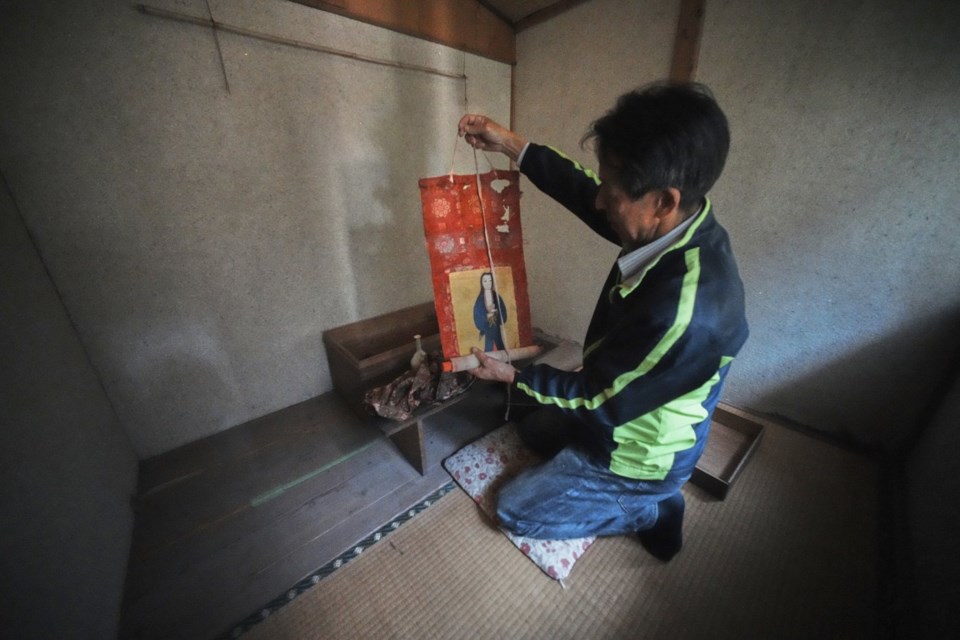IKITSUKI, Japan (AP) — On the rural islands of Nagasaki a handful of believers practice a version of Christianity that has direct links to a time of samurai, shoguns and martyred missionaries and believers.
After emerging from hiding in 1865, following centuries of violent persecution by Japan’s insular warlord rulers, many of the formerly underground Christians converted to mainstream Catholicism.
Some Hidden Christians, however, continued to follow not the religion that 16th century foreign missionaries originally taught them, but the idiosyncratic, difficult to detect version they’d nurtured during centuries of clandestine cat-and-mouse with a brutal regime.
On Ikitsuki and other remote sections of Nagasaki prefecture, Hidden Christians still pray to what they call the Closet God — scroll paintings of Mary and Jesus, disguised as a Buddhist Bodhisattva and hidden in special closets. They still chant in a Latin that hasn’t been widely used in centuries.
Now, though, the Hidden Christians are disappearing. Almost all are elderly, and as the young move to cities or turn their backs on the faith, those remaining are desperate to preserve evidence of this unique offshoot of Christianity — and convey to the world what its loss will mean.
“At this point, I’m afraid we are going to be the last ones,” said Masatsugu Tanimoto, 68, one of the few who can recite the Latin chants his ancestors learned 400 years ago.
Here are some key takeaways from The Associated Press' extensive reporting on a dwindling group of faithful who still worship today as their ancestors did when forced underground in the 17th century.
They rejected Catholicism even after the persecution ended
Christianity spread rapidly in 16th century Japan when Jesuit priests converted warlords and peasants alike, most especially on the southern main island of Kyushu, where the foreigners established trading ports in Nagasaki.
Hundreds of thousands, by some estimates, embraced the religion.
That changed after the shoguns began to see the religion as a threat. The crackdown that followed in the early 17th century was fierce.
Many continued to practice in hiding, and when Japan opened up and allowed Christianity, they emerged and became Catholics.
But others chose to stay Kakure Kirishitan (Hidden Christians), continuing to worship as their ancestors did underground.
Hidden Christianity developed when a lapse in secrecy could be deadly
Catholics have churches, priests and centuries of hard-fought dogma. But Hidden Christians were forced to hide all visible signs of their religion after the 1614 ban on Christianity and the expulsion of foreign missionaries.
Households took turns keeping precious ritual objects hidden safely and hosting the secret services that celebrated both faith and persistence.
This still happens today, and one of the most remarkable things about the religion is the ease with which an observer can feel unmoored from time, transported by rituals unchanged since the 16th century.
Different communities worship different icons and have different ways of performing the rituals.
In Sotome, for instance, people prayed to a statue of what they called Maria Kannon, a genderless Bodhisattva of mercy, as a substitute for Mary.
They take pride in clinging to the old ways
Many Hidden Christians rejected Catholicism after the persecution ended because Catholic priests refused to recognize them as real Christians unless they agreed to be rebaptized and abandon the Buddhist altars that their ancestors used.
Tanimoto believes his ancestors continued the Hidden Christian traditions because becoming Catholic meant rejecting the Buddhism and Shintoism that had become such a strong part of their daily lives underground.
“We are not doing this to worship Jesus or Mary," he said. "Our responsibility is to faithfully carry on the way our ancestors had practiced.”
An important part of Hidden Christians’ ceremonies is the recitation of Latin chants, called Orasho.
The Orasho comes from the original Latin or Portuguese prayers brought to Japan by 16th century missionaries.
Tanimoto recently showed AP a weathered copy of a prayer his grandfather wrote with a brush and ink, just like the ones his ancestors had diligently copied from older generations.
Today, because funerals are no longer held at homes and younger people are leaving the island for work and school, Orasho is only performed two or three times a year.
Hidden Christianity is dying, and the faithful know it
There were an estimated 30,000 in Nagasaki, including about 10,000 in Ikitsuki, in the 1940s, according to government figures, but nobody has been baptized since 1994.
Hidden Christianity is linked to the communal ties that formed when Japan was a largely agricultural society. Those ties crumbled as the country rapidly modernized after WWII, with recent developments revolutionizing people’s lives, even in rural Japan.
Hidden Christianity has a structural weakness, experts say, because there are no professional religious leaders tasked with teaching doctrine and adapting the religion to environmental changes.
Researchers are collecting artifacts and archiving video interviews with Hidden Christians in an attempt to preserve a record of the endangered religion.
Masashi Funabara, 63, a retired town hall official, said most of the nearby groups have disbanded over the last two decades. His group, which now has only two families, is the only one left, down from nine in his district. They used to perform prayers almost every month; now they meet only a few times a year.
“The amount of time we are responsible for these holy icons is only about 20 to 30 years, compared to the long history when our ancestors kept their faith in fear of persecution. When I imagined their suffering, I felt that I should not easily give up,” Funabara said.
Just as his father did when memorizing the Orasho, Funabara has written down passages in notebooks. He hopes the notes will help convince his son, who works for the local government, to one day be his successor.
___
Associated Press religion coverage receives support through the AP’s collaboration with The Conversation US, with funding from Lilly Endowment Inc. The AP is solely responsible for this content.
Foster Klug, The Associated Press




